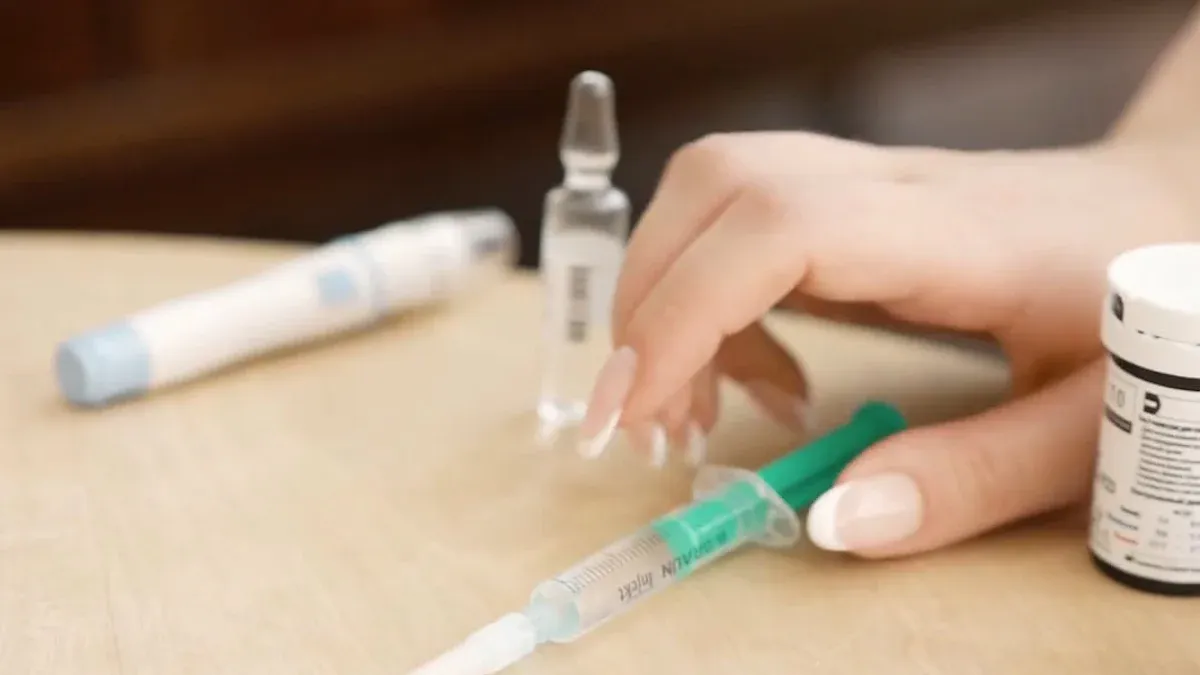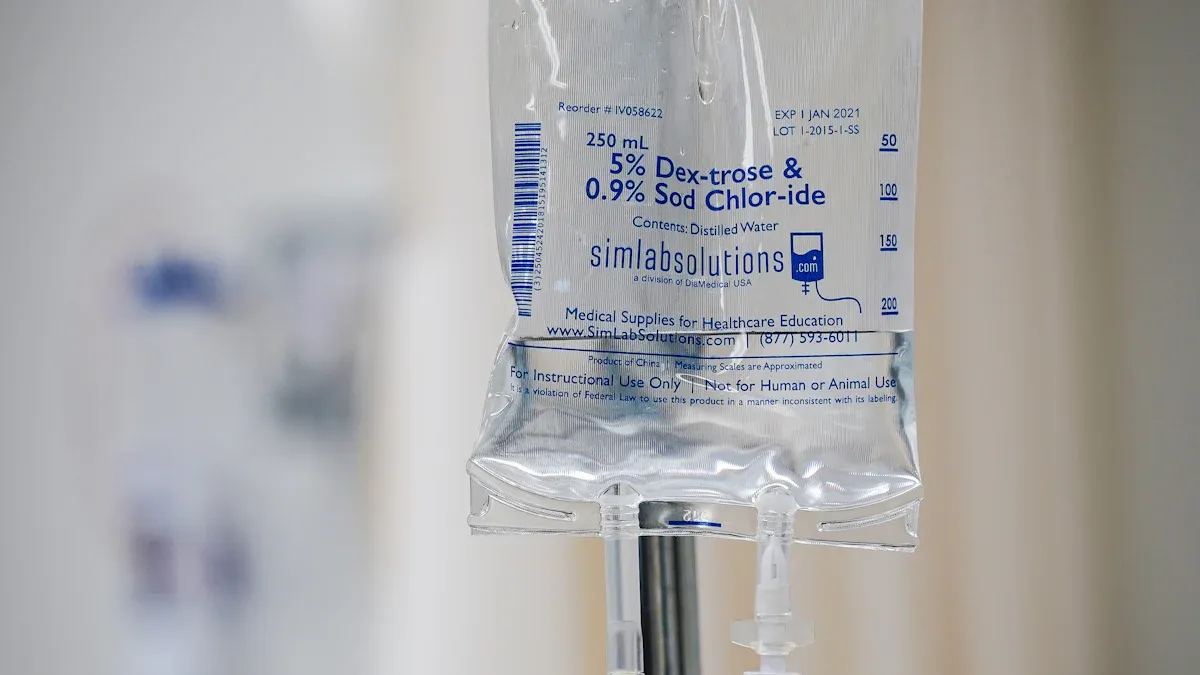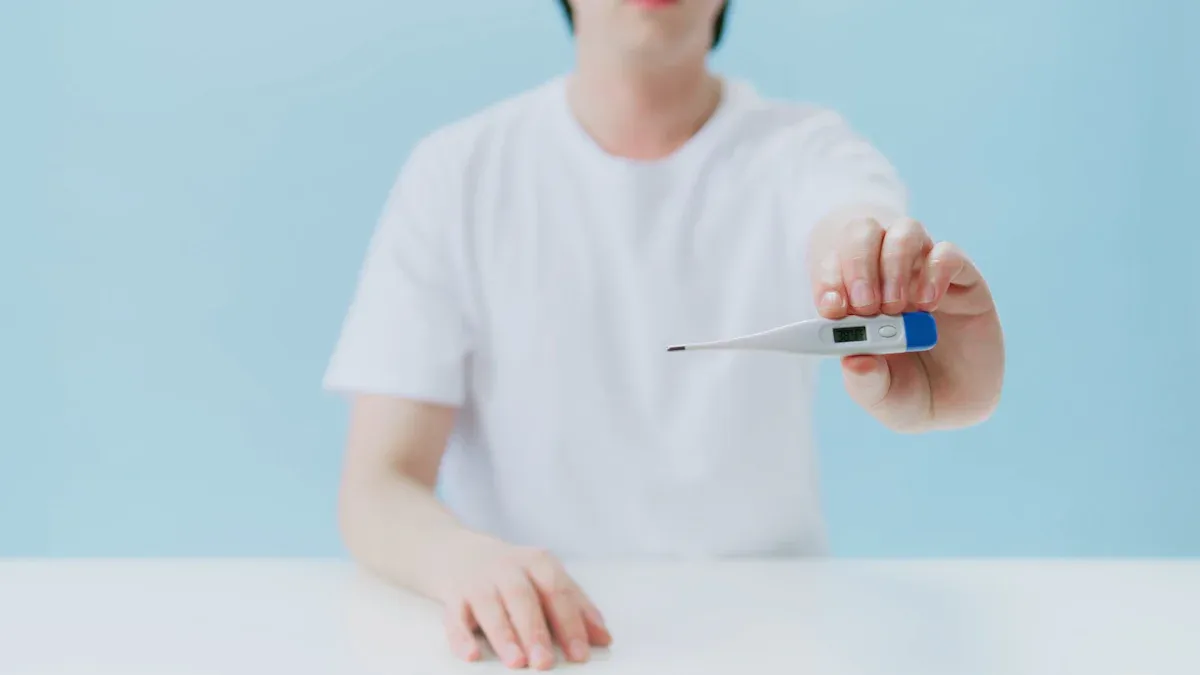How PET Shrink Tubing Improves Catheter Insulation in Medical Devices

Catheter insulation PET shrink tubing plays a crucial role in medical equipment by providing reliable insulation and strong electrical protection. This PET shrink tubing is designed with varying stiffness and a very thin profile, allowing it to fit snugly on catheters and other medical devices. Using catheter insulation PET shrink tubing enhances medical safety by delivering consistent performance and durable protection. Hospitals rely on medical equipment featuring catheter insulation PET shrink tubing because it is safe, biocompatible, and effective in protecting sensitive components. The key advantages of catheter insulation PET shrink tubing include improved patient safety and optimal device functionality. Overall, catheter insulation PET shrink tubing is essential for maintaining the safety and performance of medical devices.
Key Takeaways
PET shrink tubing gives strong and steady insulation. It protects important parts in catheters and other medical devices. Its very thin walls and strong build help catheters stay small and bend easily. This makes them simple to use and not heavy. PET tubing does not get hurt by chemicals or cleaning many times. This keeps the devices safe and long-lasting. The tubing fits closely and helps stop damage from bending or pulling. This is important during medical work. PET shrink tubing follows tough safety rules for medicine. It can also be made to fit many catheter sizes and needs.
Catheter Insulation PET Shrink Tubing

PET Heat Shrink Tubing Overview
PET heat shrink tubing is a top choice for catheter insulation in medical devices. Manufacturers pick PET because it is strong, bendable, and resists chemicals. PET heat shrink tubing fits tightly on catheters. It forms a safe layer that protects and insulates. This material works for many medical uses, like heart, brain, and urinary devices.
Medical engineers like PET heat shrink tubing because it keeps its shape during sterilization. Hospitals and clinics trust devices with PET heat shrink tubing. It does not get damaged by heat, chemicals, or being handled a lot. PET heat shrink tubing also protects delicate electronics. It makes catheter shafts stronger and helps at connection points. PET heat shrink tubing keeps medical devices working well during tough procedures.
Tip: PET heat shrink tubing can be made with special methods, like tube drawing and molecular orientation. These methods help control wall thickness and strength.
Insulation and Dielectric Properties
Insulation is very important for medical device safety and how well they work. PET heat shrink tubing has high dielectric strength. This means it can handle strong electrical fields without failing. This is needed for catheters that use electrical signals or need electrical isolation.
PET heat shrink tubing has dielectric strength over 4,000 V/mil. This makes it great for insulation in catheter use.
The tubing keeps its insulation after being sterilized by autoclaving or gamma radiation.
High dielectric strength lowers the chance of electrical problems and short circuits. This keeps patients safer when using the device.
PET tubing meets medical biocompatibility rules, like ISO 10993 and USP Class VI. This makes it good for use in blood vessel devices.
PET heat shrink tubing is flexible and tough. It fits tricky catheter shapes and can take a lot of stress.
Standard engineering numbers show how well PET heat shrink tubing works for catheter insulation:
Metric / Standard | Description / Value |
|---|---|
Tensile Strength | 500 MPa to 900 MPa |
Local Strains | Up to 6% |
Cycles to Failure | Up to 10⁷ cycles |
Strain Amplitudes | 0.5% to 2.9% |
Cold Work Percentage | 20–30% |
Dimensional Tolerances | Laser micrometers check inner diameter, outer diameter, wall thickness, and ovality |
Sterilization Compatibility | Tested for autoclaving, gamma radiation, ethylene oxide, hydrogen peroxide plasma |
Dielectric Strength | Greater than 4,000 V/mil |
Relevant Standards | UL/CSA 224, AMS-DTL-23053, ISO 10993-1:2018, FDA regulations, CE Marking |
These features make sure PET heat shrink tubing gives steady insulation and protection for medical devices in hard situations.
Ultra-Thin Wall Benefits
Ultra-thin wall PET heat shrink tubing has big benefits for catheter insulation. Thin walls make catheters smaller and easier to move through blood vessels. Studies show that thin sheaths in catheter systems lower the chance of blood vessel problems and bleeding during some heart procedures. Smaller sheaths mean fewer injuries, even for high-risk patients, which makes procedures safer.
Data also shows that adding an ultra-thin tie layer coating can make the bond between the catheter liner and jacket up to 2.5 times stronger. This makes delamination less likely, which can stop mechanical failures and keep patients safer.
Big studies with many patients prove the good things about ultra-thin designs:
Ultrathin strut drug-eluting stents lower the risk of target lesion failure by about 16% compared to regular stents.
Thinner struts mean fewer heart attacks and less stent clotting. They also cause less vessel injury and swelling.
These good results are seen with all types of ultrathin stents and last a long time.
A table shows how PET heat shrink tubing compares to other materials:
Property | PET Heat Shrink Tubing | Polyolefin Heat Shrink Tubing |
|---|---|---|
Shrink Ratio Range | 1.1:1 to 3:1 | 1.5:1 to 10:1 (commonly ~4:1) |
Wall Thickness | Ultra-thin walls, minimal bulk | Thicker compared to PET |
Tensile Strength | High tensile strength | Lower tensile strength than PET |
Device Profile Impact | Adds stiffness with minimal size increase | Larger profile increase due to thicker walls |
PET heat shrink tubing’s ultra-thin walls, high tensile strength, and exact shrink ratios let it insulate and protect without making devices bulky. This is very important for medical devices that need to bend, move easily, and keep patients comfortable.
Performance and Protection
Variable Stiffness and Flexibility
PET heat shrink tubing helps catheters be both stiff and bendy. Engineers can make the tubing thicker or thinner in different spots. Thicker parts at the back make the catheter stiffer. This helps doctors steer the device better. Thinner parts near the tip make it easier to bend. The tip can move through small or twisty blood vessels. Some catheters do not have tubing at the very end. This keeps the tip soft and gentle for safety.
Changing how stiff or flexible the catheter is helps it move safely in the body. PET heat shrink tubing does not kink or get squished easily. This means the device keeps working well. Doctors trust these catheters because they work in hard medical cases. The tubing’s bendiness and strength help the device work and keep patients safe.
Note: PET heat shrink tubing does not have exact numbers for how much stiffness changes, but its design lets it go from stiff to bendy along the catheter.
Mechanical and Chemical Resistance
PET heat shrink tubing acts like a strong cover for catheters. It protects them from scratches, bumps, and harsh hospital chemicals. The tubing stays strong even after being cleaned many times. For example, it keeps over 88% of its strength after 50 cleanings with hydrogen peroxide. This means it can be cleaned a lot and still protect the device.
The table below shows how PET heat shrink tubing does in tough situations:
Property | Performance | Importance for Devices |
|---|---|---|
Tensile Strength Retention | Over 88% after 50 sterilizations | Maintains durability and protection |
Biocompatibility Standards | Meets ISO 10993, USP Class VI | Safe for patient use |
Sterilization Compatibility | Passes ISO 17665-1:2023 autoclaving | Withstands hospital cleaning |
Dimensional Stability | Keeps shape for up to 18 months in trials | Ensures long-term reliability |
PET heat shrink tubing also keeps out water and dirt. This helps protect the inside of the device. The tubing’s toughness means catheters last longer and work better. Hospitals pick these catheters because they are strong and work every time.
Secure Fit and Strain Relief
PET heat shrink tubing makes a tight fit around catheters and other devices. When heated, the tubing shrinks and holds the device close. This tight fit gives strain relief. That means it helps protect the device from pulling, bending, or twisting. The tubing is strong and bendy, so it can handle rough use without slipping or breaking.
Doctors and nurses need devices that stay together when used. PET heat shrink tubing keeps connectors and joints safe, even when the device bends or moves. The tubing’s strength helps stop problems that could hurt patients. Its tight fit also keeps out water and dirt, giving more protection.
Tip: PET heat shrink tubing’s tight fit and strain relief make it a great choice for devices that need to last and work well in busy hospitals.
Biocompatibility and Sterilization Resistance

Medical-Grade PET
Medical-grade PET is important in medical devices. It has high biocompatibility, so it works well with the body. Doctors and engineers pick PET for catheters because it does not cause bad reactions. Medical PET follows strict safety rules for biocompatible applications. It passes tests for touching skin and blood. Hospitals trust PET because it keeps patients safe during many procedures. The smooth surface of PET helps lower infection risk. Medical teams use PET in many devices because it helps with safety and performance.
Sterilization Compatibility
Sterilization is needed for every medical device. PET can handle many ways of sterilization without losing strength or shape. Hospitals use steam, gamma rays, and chemicals to clean devices. PET keeps its biocompatibility after each cleaning. This makes it great for biocompatible applications that need to be cleaned often. The table below shows how PET does in different sterilization methods:
Sterilization Method | PET Performance |
|---|---|
Steam (Autoclave) | No damage, keeps shape |
Gamma Radiation | Maintains strength |
Ethylene Oxide | No loss of safety |
Hydrogen Peroxide Plasma | Stays biocompatible |
Tip: PET can go through up to 10 sterilization cycles and still keep its medical properties.
Medical teams count on PET for devices that need strong sterilization resistance. This helps keep patients safe and makes medical tools last longer.
Patient Safety
Patient safety is always the most important thing in hospitals. PET helps protect patients with its strong biocompatibility and sterilization resistance. Doctors use PET in catheters because it does not break down when cleaned. This keeps the device safe every time it is used. PET also helps lower the risk of infection and allergic reactions. Hospitals pick PET because it has a good safety record. Medical staff trust PET to keep patients safe during all procedures.
PET’s biocompatibility and sterilization resistance make it a top choice for medical devices that need the highest safety.
Suitability and Compliance
Customization Options
PET heat shrink tubing lets engineers change catheters in many ways. They can pick different sizes, wall thicknesses, shrink ratios, and colors. This helps the tubing work for many types of medical devices. The table below lists some choices for PET heat shrink tubing:
Specification | Range/Options |
|---|---|
Inner Diameter (mm) | 0.2 to 8.5 (0.008 to 0.335 in) |
Wall Thickness (mm) | 0.005 to 0.200 (0.0002 to 0.008 in) |
Shrink Ratio | 1.15:1, 1.5:1, 2:1, up to 4:1 |
Color | Clear, Black, White, Custom |
PET heat shrink tubing works for both how a device looks and how it works. It fits catheters of all sizes, from tiny to big. PET is picked a lot because it is strong and resists chemicals. It also helps companies finish orders fast. Some companies can make custom tubing in just three weeks. This makes it easy to make new devices quickly.
Regulatory Standards
PET heat shrink tubing follows strict rules for medical devices. These rules help keep patients safe and make sure devices are good quality. PET passes important tests like ISO 10993 and USP Class VI. It also meets FDA rules and ISO 17665-1:2023 for cleaning. Quality checks include:
Checking size
Testing for safety and strength
Making sure it can be cleaned well
Looking for any problems
Engineers and tubing makers work together to make sure the tubing fits each device. They also make sure it follows all the rules. This teamwork helps keep medical devices safe and reliable.
Cost and Integration
PET heat shrink tubing helps save money for device makers. It lasts a long time, so devices do not break as much. PET tubing shrinks at low heat, so it does not hurt sensitive parts. It also seals tightly, which helps stop leaks. The table below shows why PET heat shrink tubing is good for many catheter sizes:
Evidence Aspect | Supporting Details |
|---|---|
Biocompatibility and Safety | Meets ISO 10993 and USP Class VI |
Mechanical Performance | High fatigue life, tensile strength, flexibility |
Sterilization Compatibility | Handles autoclaving, gamma, peroxide, ethylene oxide |
Thermal Properties | Shrinks at ~90°C, stable from -196°C to 200°C |
Application Fit | Excellent sealing, minimal wash-out |
Durability and Flexibility | Maintains structure under stress |
Regulatory Compliance | Meets FDA and ISO standards |
PET heat shrink tubing helps device makers follow the rules and save money. Its strength, long life, and easy use make it a smart pick for new medical devices.
PET heat shrink tubing makes catheter insulation much better in medical tools. PET has strong dielectric strength and fits catheters very well. It is also tough and lasts a long time. Medical teams like that PET is safe for the body and helps keep patients safe. PET heat shrink tubing lets devices have different stiffness, so they work better and are more dependable. Hospitals use PET because it does not get ruined by chemicals or cleaning many times. PET heat shrink tubing is not expensive and can be changed to fit different needs. These things help make patients safer and improve results, so PET is picked for new medical tools.
PET heat shrink tubing gives:
Steady insulation and dependability
Great safety and good results in hospitals
Long use for medical tools
FAQ
What makes PET shrink tubing ideal for medical catheters?
PET shrink tubing gives strong insulation and fits tightly. Medical teams pick it because it does not get damaged by chemicals. It helps catheters bend and last a long time. Hospitals use PET for many kinds of medical work.
How does PET tubing improve patient safety in medical devices?
PET tubing keeps important parts inside catheters safe. It blocks water and dirt from getting in. Medical workers use PET to help stop infections. PET follows strict safety rules, so patients stay safe every time.
Can PET shrink tubing handle repeated sterilization in medical settings?
Yes, PET shrink tubing keeps its shape and strength after many cleanings. Medical teams use steam, gamma rays, and chemicals to clean tools. PET stays safe and works well, even after lots of cleaning. This is why it is used in many medical tools.
Is PET shrink tubing customizable for different medical devices?
Engineers can get PET shrink tubing in many sizes, colors, and thicknesses. Device makers like PET because it fits many catheter shapes. PET works for both small and big devices, so it is good for many needs.
What standards does PET shrink tubing meet for medical use?
PET shrink tubing passes important tests like ISO 10993 and USP Class VI. Device makers trust PET because it meets FDA rules. Hospitals use PET in many tools because it follows strict safety and quality rules.
See Also
Top Uses Of Ultrathin PET Heat Shrink Tubing In Medicine
The Importance Of Ultra-Thin PET Tubing In Medical Tech
Building Multi-Layer Catheters With Medical Grade FEP Tubing
Enhancing Neurosurgical Catheters Using FEP Heat Shrink Tubing
Essential Facts About PET Heat Shrink Tubing For Electronics

